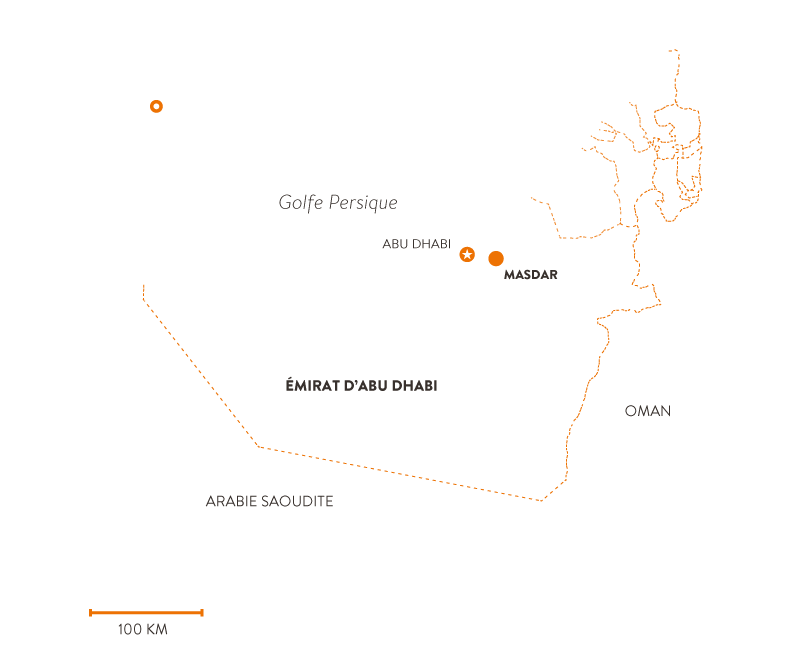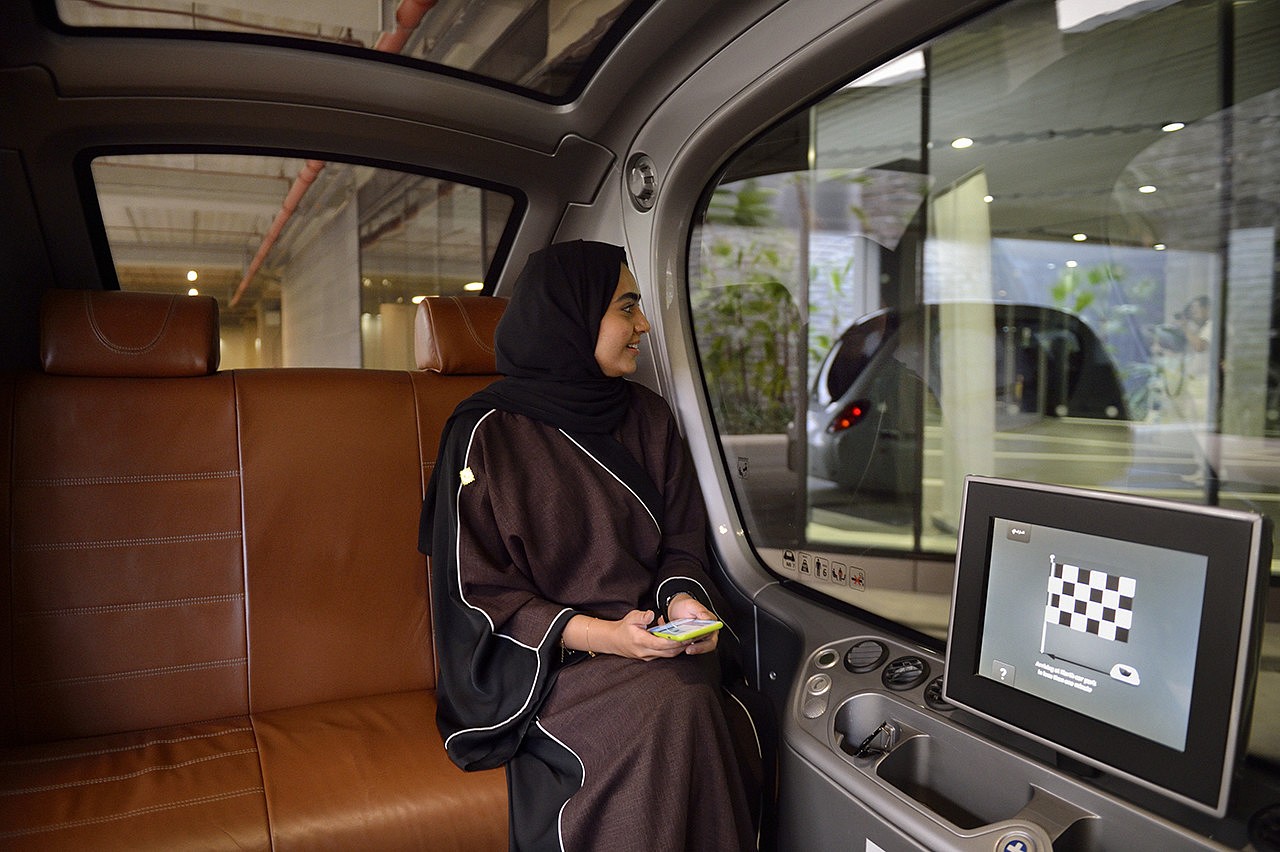-
United Arab Emirates
-
Masdar City, an experimental city in the land of black gold
 In the desert sands of Abu Dhabi, the emirate that produces 90% of the United Arab Emirates’ oil, in 2008, an experimental, low-carbon city began to emerge: Masdar (in Arabic, «the source … of all life»). This oasis has a university at its centre, specialising in the cutting-edge technologies of sustainable development, the Masdar Institute of Science and Technology (MIST).
In the desert sands of Abu Dhabi, the emirate that produces 90% of the United Arab Emirates’ oil, in 2008, an experimental, low-carbon city began to emerge: Masdar (in Arabic, «the source … of all life»). This oasis has a university at its centre, specialising in the cutting-edge technologies of sustainable development, the Masdar Institute of Science and Technology (MIST). Every day, five hundred students are experimenting the life of tomorrow in this city designed as a life-size test lab. But why back green energies in the land of black gold? According to the WWF’s latest Living Planet Report 2014, the United Arab Emirates’ per capita environmental footprint is the third largest in the world. If everyone on the Earth lived like the people of this Persian Gulf State, we would need five planets to meet our needs.
Texts: Aude Raux | Photography: Laurent WeylMasdar City, an experimental city in the land of black gold
 In the desert sands of Abu Dhabi, the emirate that produces 90% of the United Arab Emirates’ oil, in 2008, an experimental, low-carbon city began to emerge: Masdar (in Arabic, «the source … of all life»). This oasis has a university at its centre, specialising in the cutting-edge technologies of sustainable development, the Masdar Institute of Science and Technology (MIST).
In the desert sands of Abu Dhabi, the emirate that produces 90% of the United Arab Emirates’ oil, in 2008, an experimental, low-carbon city began to emerge: Masdar (in Arabic, «the source … of all life»). This oasis has a university at its centre, specialising in the cutting-edge technologies of sustainable development, the Masdar Institute of Science and Technology (MIST). Every day, five hundred students are experimenting the life of tomorrow in this city designed as a life-size test lab. But why back green energies in the land of black gold? According to the WWF’s latest Living Planet Report 2014, the United Arab Emirates’ per capita environmental footprint is the third largest in the world. If everyone on the Earth lived like the people of this Persian Gulf State, we would need five planets to meet our needs.
Texts: Aude Raux | Photography: Laurent Weyl 

Aware of the limits of their oil and gas reserves, Abu Dhabi is preparing for the post-oil era. To remain a leader in the energy market, an experimental, low-carbon city emerged In the desert sands of this emirate : Masdar, a low-carbon city.

Because of the economic crisis of 2008-2009, the building work has fallen behind schedule. For the moment, 10% of the city has been or is in the course of being built. The entire city, covering an area of 6 km2, will be completed by 2030. The first residents are expected to arrive in 2017.

To move on from being a simple supplier of energy to being a knowledge economy, Abu Dhabi created the Masdar Institute of Science and Technology (MIST). In the eyes of its students, Masdar City resembles a «flying saucer that has landed in the desert». Here, the library.

To enter Masdar, you have to leave your car at the city gates - which is entirely pedestrianized - and use a driverless automatic electric pod car : a «personal rapid transit» vehicle.
Tomorrow, the “kings of the sun”
It is not out of philanthropy that the leaders of this State, which possesses the eighth-largest oil reserves and the seventh-largest gas reserves in the world, are turning to «clean» energies, favouring solar energy, an unlimited resource in a country where the sun shines 350 days a year. Aware that their reserves will one day run out, their aim is to remain one of the leaders on the energy market. And to move on from being a simple supplier of energy to being a knowledge economy. Which explains the creation of the Masdar Institute of Science and Technology (MIST). «Here, they have understood that education is the key to changing behaviour. Studies are free, and students’ expenses are covered, and compared to Europe the amounts allocated to the laboratories are multiplied tenfold. Today, they are the kings of oil. Tomorrow, they will be the kings of the sun» predicts Nicolas Calvet, the only Frenchman among the ninety-three teachers at the MIST. And yet the irony of the situation does not escape him: «We are being funded by oil money to do research on renewable energies.»
Tomorrow, the “kings of the sun”
It is not out of philanthropy that the leaders of this State, which possesses the eighth-largest oil reserves and the seventh-largest gas reserves in the world, are turning to «clean» energies, favouring solar energy, an unlimited resource in a country where the sun shines 350 days a year. Aware that their reserves will one day run out, their aim is to remain one of the leaders on the energy market. And to move on from being a simple supplier of energy to being a knowledge economy. Which explains the creation of the Masdar Institute of Science and Technology (MIST). «Here, they have understood that education is the key to changing behaviour. Studies are free, and students’ expenses are covered, and compared to Europe the amounts allocated to the laboratories are multiplied tenfold. Today, they are the kings of oil. Tomorrow, they will be the kings of the sun» predicts Nicolas Calvet, the only Frenchman among the ninety-three teachers at the MIST. And yet the irony of the situation does not escape him: «We are being funded by oil money to do research on renewable energies.»
Masdar is a post-carbon platform. Cities, where 50% of the world’s population now live, produce 75% of carbon emissions. To combat global warming, the answer is not to dominate nature, but to understand it. And then to work with it. Finally, to implement technology to increase our comfort zone. From now on, we must do more with less. Masdar is the tangible proof that, even in a hostile environment, it is possible.”
Anthony Mallows, director of Masdar CityMasdar is a post-carbon platform. Cities, where 50% of the world’s population now live, produce 75% of carbon emissions. To combat global warming, the answer is not to dominate nature, but to understand it. And then to work with it. Finally, to implement technology to increase our comfort zone. From now on, we must do more with less. Masdar is the tangible proof that, even in a hostile environment, it is possible.”
Anthony Mallows, director of Masdar City
Foster and Partners, the firm of architects that designed the city, took their inspiration from ancestral Arabic construction practices and modernised them. Like this 45-metre high wind tower built of recycled steel and reminiscent of the traditional badgir windcatchers used to create natural ventilation in houses.
-
Playing with shadows and light
The architects of the British firm Foster and Partners, who designed this pioneering city, took their inspiration from ancestral Arabic construction practices, modernising them and enhancing local know-how. In this country where temperatures can reach 50°C and every drop of water has to be desalinated, the high-tech passive design reduces energy costs. The streets in Masdar City, like those of the medinas, are narrow, short and shaded. The very opposite of the boulevards of Abu Dhabi City and their crushing heat. Similarly, this pedestrianised city – a revolution in the kingdom of the 4WD – is compact and densely built, unlike the urban spread of the Emirate’s capital. «Here exposure to the sun has been reduced by 90%, which enables us to make savings on air conditioning,» explains Chris Wan, head of design. The windows, for example, never cover more than 30% of the facades. Elsewhere, how many buildings have both huge windows and curtains? It doesn’t make sense.» As Nawal Al Hosany, sustainable development manager, sums up, «Every detail in the city is the subject of research in itself.»
Playing with shadows and light
The architects of the British firm Foster and Partners, who designed this pioneering city, took their inspiration from ancestral Arabic construction practices, modernising them and enhancing local know-how. In this country where temperatures can reach 50°C and every drop of water has to be desalinated, the high-tech passive design reduces energy costs. The streets in Masdar City, like those of the medinas, are narrow, short and shaded. The very opposite of the boulevards of Abu Dhabi City and their crushing heat. Similarly, this pedestrianised city – a revolution in the kingdom of the 4WD – is compact and densely built, unlike the urban spread of the Emirate’s capital. «Here exposure to the sun has been reduced by 90%, which enables us to make savings on air conditioning,» explains Chris Wan, head of design. The windows, for example, never cover more than 30% of the facades. Elsewhere, how many buildings have both huge windows and curtains? It doesn’t make sense.» As Nawal Al Hosany, sustainable development manager, sums up, «Every detail in the city is the subject of research in itself.»
(Français)
Attirer la vie
En 2014, Siemens a établi son siège social pour le Moyen-Orient à Masdar City. Puis, en 2015, l’Agence internationale de l’énergie renouvelable (Irena) y a ouvert ses portes. Après la connaissance et le business, il faut encore attirer la vie, afin de faire battre le cœur de Masdar City. Or, l’Émirat d’Abu Dhabi a, lui aussi, été touché par la crise économique de 2008. Conséquence, les ambitions ont été revues à la baisse sur le plan technologique. Et le chantier a pris du retard. Même si le budget reste pharaonique : 18 milliards de pétrodollars. En 2011, la stratégie a été redéfinie. La ville, d’une surface de 6 km2, sera aménagée quartier par quartier. D’ici à 2030, Masdar City accueillera 1000 étudiants, 50 000 employés dans les entreprises qui s’y seront installées et 40 000 habitants.